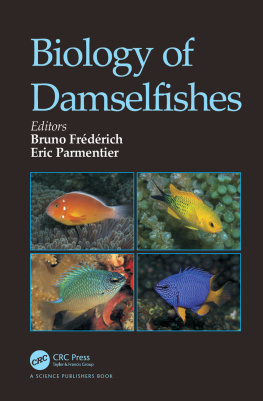Fr?ed?erich Bruno - Biology of damselfishes
Here you can read online Fr?ed?erich Bruno - Biology of damselfishes full text of the book (entire story) in english for free. Download pdf and epub, get meaning, cover and reviews about this ebook. year: 2016, publisher: CRC Press, genre: Romance novel. Description of the work, (preface) as well as reviews are available. Best literature library LitArk.com created for fans of good reading and offers a wide selection of genres:
Romance novel
Science fiction
Adventure
Detective
Science
History
Home and family
Prose
Art
Politics
Computer
Non-fiction
Religion
Business
Children
Humor
Choose a favorite category and find really read worthwhile books. Enjoy immersion in the world of imagination, feel the emotions of the characters or learn something new for yourself, make an fascinating discovery.
- Book:Biology of damselfishes
- Author:
- Publisher:CRC Press
- Genre:
- Year:2016
- Rating:3 / 5
- Favourites:Add to favourites
- Your mark:
- 60
- 1
- 2
- 3
- 4
- 5
Biology of damselfishes: summary, description and annotation
We offer to read an annotation, description, summary or preface (depends on what the author of the book "Biology of damselfishes" wrote himself). If you haven't found the necessary information about the book — write in the comments, we will try to find it.
Biology of damselfishes — read online for free the complete book (whole text) full work
Below is the text of the book, divided by pages. System saving the place of the last page read, allows you to conveniently read the book "Biology of damselfishes" online for free, without having to search again every time where you left off. Put a bookmark, and you can go to the page where you finished reading at any time.
Font size:
Interval:
Bookmark:

Biology of Damselfishes
Biology of Damselfishes
Editors
Dr. Bruno Frdrich
Laboratoire de Morphologie Fonctionnelle et volutive
AFFISH Research Center
Universit de Lige
Lige
Belgium
Prof. Eric Parmentier
Laboratoire de Morphologie Fonctionnelle et Evolutive
AFFISH Research Center
Universit de Lige
Lige
Belgium

CRC Press
Taylor & Francis Group
6000 Broken Sound Parkway NW, Suite 300
Boca Raton, FL 33487-2742
2016 by Taylor & Francis Group, LLC
CRC Press is an imprint of Taylor & Francis Group, an Informa business
No claim to original U.S. Government works
Printed on acid-free paper
Version Date: 20160126
International Standard Book Number-13: 978-1-4822-1209-9 (Hardback)
This book contains information obtained from authentic and highly regarded sources. Reasonable efforts have been made to publish reliable data and information, but the author and publisher cannot assume responsibility for the validity of all materials or the consequences of their use. The authors and publishers have attempted to trace the copyright holders of all material reproduced in this publication and apologize to copyright holders if permission to publish in this form has not been obtained. If any copyright material has not been acknowledged please write and let us know so we may rectify in any future reprint.
Except as permitted under U.S. Copyright Law, no part of this book may be reprinted, reproduced, transmitted, or utilized in any form by any electronic, mechanical, or other means, now known or hereafter invented, including photocopying, microfilming, and recording, or in any information storage or retrieval system, without written permission from the publishers.
For permission to photocopy or use material electronically from this work, please access www.copyright.com (http://www.copyright.com/) or contact the Copyright Clearance Center, Inc. (CCC), 222 Rosewood Drive, Danvers, MA 01923, 978-750-8400. CCC is a not-for-profit organization that provides licenses and registration for a variety of users. For organizations that have been granted a photocopy license by the CCC, a separate system of payment has been arranged.
Trademark Notice: Product or corporate names may be trademarks or registered trademarks, and are used only for identification and explanation without intent to infringe.
Library of Congress Cataloging-in-Publication Data
Names: Frdrich, Bruno. | Parmentier, Eric.
Title: Biology of damselfishes / [edited by] Bruno Frdrich and Eric Parmentier.
Description: Boca Raton : Taylor & Francis, 2016. | A CRC title. | Includes bibliographical references and index.
Identifiers: LCCN 2015048045 | ISBN 9781482212099 (hardcover : alk. paper)
Subjects: LCSH: Pomacentridae. | Coral reef fishes.
Classification: LCC SF458.P66 B56 2016 | DDC 639.3/772--dc23
LC record available at http://lccn.loc.gov/2015048045
Visit the Taylor & Francis Web site at
http://www.taylorandfrancis.com
and the CRC Press Web site at
http://www.crcpress.com
Damselfishes have long captured the attention of taxonomists, ecologists, and especially students of reef fish behaviour. The very large size of this family in combination with their occurrence over a wide range of habitats and very interesting breeding biology, have served to continually keep this group in the limelight. Moreover, these fishes are highly conspicuous, diurnal inhabitants of mainly shallow reef areas, lending themselves especially well to intense study. Another asset is their ready acceptance of aquarium conditions, making them excellent subjects for captive laboratory studies involving various aspects of physiology, reproduction, growth and general behaviour.
I first became involved with this fascinating family in the mid-1960s during graduate studies at the University of Hawaii under the tutelage of Dr. Jack Randall. The topic of my PhD thesis was the classification and biology of the anemonefishes. They seemed a perfect target for research activities. Firstly, the classification was confused and presented a huge challenge and secondly there was scant documentation of their intriguing natural history. After graduation my interest in the family took a quantum leap when I accepted a fisheries job at Palau on the edge of what we now refer to as the Coral Triangle, the global centre of reef fish diversity. Compared to Hawaii and the Marshall Islands, the site of my graduate field studies, Palau harboured an amazingly rich fauna. It proved an excellent location for honing field identification skills and an opportunity for a close-up and personal approach to the study of pomacentrids. The die was cast and from that point onwards this intriguing family became a focal point of research that continues to this day, nearly 50 years later.
It is most gratifying to see that my passion for pomacentrid fishes is now shared by so many others. When I look back to the early years of graduate school, there was a general scarcity of taxonomic information. Weber and De Beauforts classical Indo-Australian Fishes was the primary source of knowledge for the species-rich East Indian region. The Pomacentridae was covered in Volume VIII (1940), which included brief descriptions of 86 species in 11 genera. Now, 73 years later, the most recent tally (Allen and Erdmann 2012) is 187 species belonging to 21 genera. Worldwide we are fast approaching the 400 species mark, which represents the fourth richest marine-fish group after the Gobiidae, Serranidae, and Labridae. Modern genetic techniques in particular have opened a new chapter for our understanding of natural relationships and the existence of what appears to be many as yet undescribed cryptic species.
The advent of the Catalog of Fishes, the product of William N. Eschmeyer, former Curator of Fishes at the California Academy of Sciences has greatly facilitated the taxonomic process, resulting in a high level of accuracy while saving huge amounts of time. I vividly recall the painstaking process of compiling a complete inventory of taxonomic literature associated with the genus Amphiprion while working on my PhD thesis. Hours were spent for days on end tracking down various references, which were then hand-written on 3 x 5 cards. Now, thanks to the computerised Catalog, it takes a single click of the mouse and about five seconds to produce an annotated list of every nominal species (about 800) of Pomacentridae. The extreme value of this taxonomic tool cannot be overstated!
Back in the 1960s there was little accurate knowledge of pomacentrid natural history. Sex reversal, now well documented for Amphipiron, was still unknown. Not surprising, prior to the widespread use of scuba gear by diving scientists there was a general lack of information pertaining to damselfish behaviour and ecology. One notable exception was the detailed aquarium study of Amphiprion and their special relationship with sea anemones conducted at Java by Verwey (1930) in the 1920s. Thankfully, scuba diving has given us almost unlimited access to the previously unknown, private world of damselfishes, resulting in a large body of knowledge, particularly related to their ecology and various aspects of biology, including the fascinating realm of reproduction. Fast forward to 2015 and there is phenomenal interest in pomacentrids and a rapidly expanding literature base that now includes hundreds of published studies. The present volume is particularly timely and gratifying. It represents an excellent compilation of the current state of knowledge on a wide range of topics by leading researchers in the field. Highly informative, state of the art chapters cover a wide range of topics relating to crucial aspects of damselfish taxonomy, life history, ecology and habitat use, as well as the latest word on a variety of other subjects.
Font size:
Interval:
Bookmark:
Similar books «Biology of damselfishes»
Look at similar books to Biology of damselfishes. We have selected literature similar in name and meaning in the hope of providing readers with more options to find new, interesting, not yet read works.
Discussion, reviews of the book Biology of damselfishes and just readers' own opinions. Leave your comments, write what you think about the work, its meaning or the main characters. Specify what exactly you liked and what you didn't like, and why you think so.












![Bruno Skvorc [Bruno Skvorc] - Build Your First Ethereum DApp](/uploads/posts/book/119691/thumbs/bruno-skvorc-bruno-skvorc-build-your-first.jpg)
